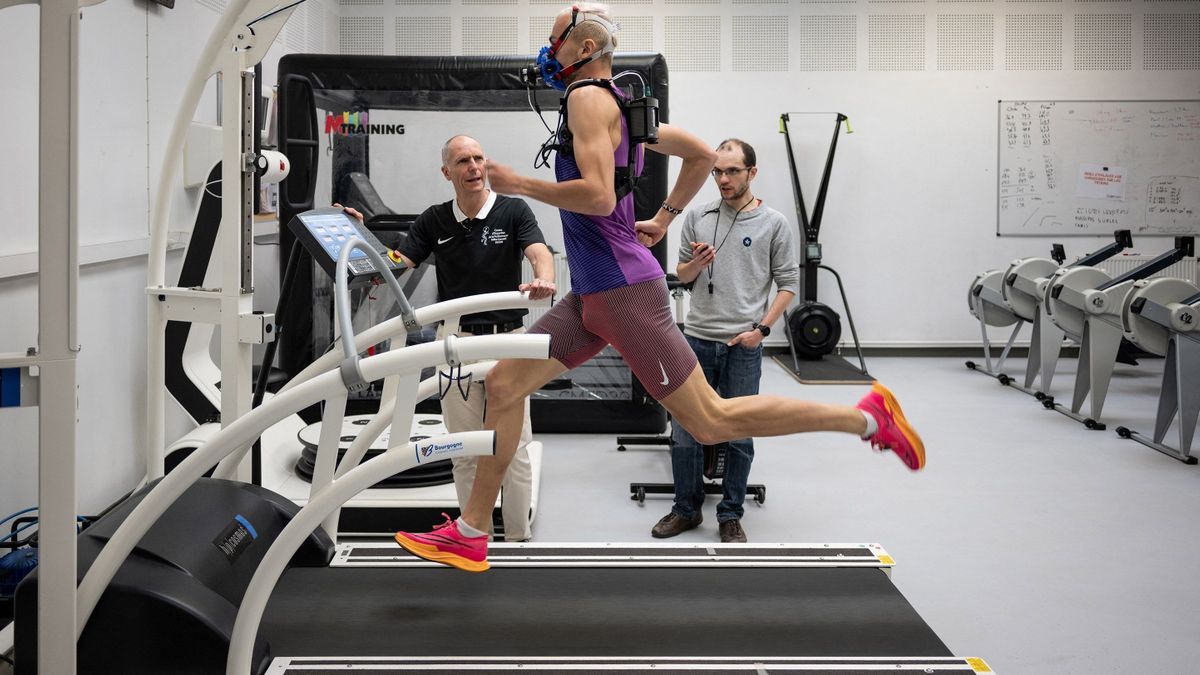
“Reach the highest level possible”. In Dijon, athletes train in an Inserm laboratory entirely dedicated to the study of movement. Objective: improve their performances, sometimes with a view to the Olympics, while advancing research.
Théo De Meyere, 23, is launched at more than 26 km/hour on a treadmill at this Center of Expertise and Performance (CEP). A specialist in the 800 meters, he was equipped with a mask and a harness which records his oxygen consumption and CO2 production.
After a 400 meters in “normal” conditions, the high-level athlete must achieve the same performance in a tent in “hypoxia”, that is to say while being deprived of some oxygen.
“It's like he's running at 2,000 meters above sea level.“, explains Hervé Assadi, his trainer, researcher at the CAPS unit (Cognition, action and sensorimotor plasticity) at Inserm, of which the center of expertise is a part.
During a second passage under the tent, the runner stops, exhausted, without being able to complete the distance.
“We try to push the limits of knowledge of the body and sports performance“, decodes his trainer. “By depriving him of oxygen, we make his session more difficult; If he still manages to maintain his speed, he will have an advantage in the 800 meter final during the elite French championship at the end of June, qualifying for the Olympics.”he adds.
“The goal is to allow him to reach the highest possible level.“.
“New toys”
Corentin Le Guen and Sébastien Verdin, both members of the French disabled rugby team, a priori selected for the Paralympic Games, also train in this structure in Dijon, where they come to seek “quality rather than quantity” .
“We're a bit like children, we test new toys“, laughs Corentin Le Guen in his armchair. Deprived of the use of his legs, he wants to work on the endurance of his upper limbs”to be able to hold out over a very long competition“.
His teammate is getting ready to try hypoxia training: “I'm going to see how my body reacts; if it is beneficial, if it does not create too much fatigue, I will repeat the experience in July before the Games“, he predicts.
“Three times a year, our athletes undergo a battery of complete tests: we measure the way their body produces energy, their muscular strength, etc.“, describes Carole Cometti, director of the CEP at Inserm, who follows the athletes' sessions on a daily basis. “If we see that they are not progressing, we will change their training“, she assures.
“We are able to analyze the complete architecture of a muscle: if it is more or less thick, if it is able to produce this or that force, if there is fatigue induced by a particular exercise“, lists Nicolas Babault, Inserm researcher and professor at the University of Burgundy. “This allows us to optimize training.”.
Infra-red cameras
If all these tests are intended to increase the abilities of athletes, they also aim to advance research.
“This is what makes our unity“, where between 100 and 150 athletes train per day, is “unique in Europe”, boasts its director, Charalambos Papaxanthis.
Inserm scientists are studying the neurophysiological mechanisms of motor skills in detail. “If we understand how the brain controls a movement, we can put this knowledge at the service of a wider audience such as a patient in rehabilitation or an elderly person in Ephad…“, unfolds Mr. Papaxanthis.
The researchers have equipped the center with a battery of equipment – infrared analysis cameras, electrodes for calculating muscular activity, robots, ground sensors measuring peak speed, number of steps or height of jumps, etc.
Technologies and mathematical calculations which must lead to very concrete applications.
Electrostimulation, which reduces the feeling of physical effort, could for example benefit bedridden patients by preserving part of their muscular activity, or even patients who have had a stroke, according to Inserm researchers.
